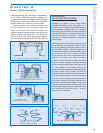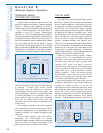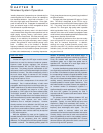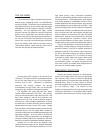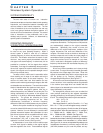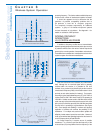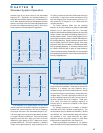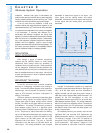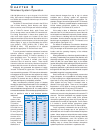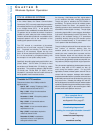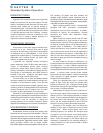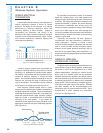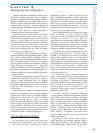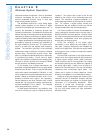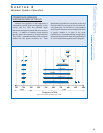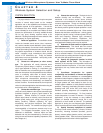
180-186 MHz and so on up to channel 13 at 210-216
MHz. UHF channel 14 begins at 470 MHz and extends
to 476 MHz with successive channels up to channel 69
at 800-806 MHz.
The 6 MHz/TV channel block is found in the US, the
rest of North America, South America and Japan.
Other countries, most of Europe and India for example,
use a 7 MHz/TV channel block, while France and
China, among others, use an 8 MHz/TV channel block.
For analog transmission in these other systems, the
video and audio signals are located at the same
frequencies relative to the channel boundaries as in the
6 MHz systems, but the frequency of the chroma signal
differs slightly in each to accommodate the various
color systems: NTSC (6 MHz), PAL (7 MHz), and
SECAM (8 MHz). DTV proposals for all systems
specify the appropriate TV channel block sizes.
To avoid potential interference between broadcast
television stations, regulatory agencies have not
allowed adjacent analog TV channel operation in a
given geographic area. For example, in the US, if a
local analog TV channel 9 existed, then analog
channels 8 and 10 would be vacant. These vacant
channels could then be used by wireless microphone
systems with little concern for television interference.
Historically, this guaranteed the existence of certain
"unused" TV channels in a given area. The advent of DTV
has removed this guarantee. DTV channels are allowed to
exist adjacent to each other and also adjacent to existing
analog TV channels. This has resulted not only in more
occupied TV channels but also in difficulty using earlier
"pre-selected" frequency compatibility schemes.
Many manufacturers pre-select groups of wireless
microphone system frequencies based on the availability of
vacant TV channels. They also have information on TV
channel distribution throughout the US. It is usually sufficient
to indicate the destination of the wireless equipment at the time
that it is specified in order to avoid broadcast television
interference.
One conse-
quence of the
relatively dense
TV channel
distribution in the
US is that it is not
generally possible
to use a given set
of fixed-frequency
wireless micro-
phone systems
everywhere in the
country. As the
distribution of
vacant channels changes from city to city it is almost
inevitable that a "touring" system will experience
interference from a television station in some location. For
example, Chicago has active high-band VHF TV channels
7, 9, and 11. Therefore, a suitable setup for use there would
include wireless microphone systems on frequencies
corresponding to TV channels 8, 10, and/or 12.
If this setup is taken to Milwaukee, which has TV
channels 8 and 10, it is likely that one or more of the units
would experience interference, especially if used outdoors
or even indoors in a building near one of those television
transmitters. A similar situation may also occur in the UHF
band though the distribution of UHF TV channels is not
quite as dense. (See Figure 3-12.)
The effects of interference from television broadcast
are dependent on the type of television signal (analog or
DTV), the strength of the television signal, as well as the
location and the operating frequency of the wireless
microphone system.
Direct conflicts with any of the three signals that make up
an analog TV transmission can produce noise, distortion, and
short range or dropout. Pickup of the video or chroma signals
(which are AM) can cause distinct "buzz" in the wireless
receiver, while pickup of the audio signal (FM) will result in the
TV sound being heard. It is sometimes possible to use
frequencies just above or just below the chroma carrier since
that signal has the least power and the narrowest occupied
bandwidth, though this is not always reliable.
Direct conflict with a DTV signal usually causes short
range or dropouts. It is not possible for an analog receiver
to "hear" anything from a digital transmission but the DTV
signal acts as a very strong broadband noise source. In
some systems this may result in increased noise or
distortion in the audio output. There are no "unoccupied"
frequencies in a DTV signal so it may not be possible to
operate anywhere within a very strong DTV channel.
The most effective solution for broadcast television
interference is to avoid using frequencies of local active TV
channels. Television transmitters may operate at power
levels up to several million watts while wireless
microphone systems typically have only 50 mw (fifty one-
thousandths of one watt!) of output power. For this reason
it is unwise to choose wireless microphone system
frequencies that fall in an active local TV channel block.
"Local" is generally considered to be up to 50 miles,
depending on the coverage area of the particular TV
transmitter and on the location of the wireless microphone
system. Indoor setups are at less risk than outdoor setups
because building structures will usually strongly attenuate
TV signals. Nevertheless, since the locations and
assignments of television stations are well known it is
relatively easy to choose fixed wireless microphone
system frequencies to avoid them in a particular area.
29
Selection
and Operation
of Wireless Microphone Systems
C HAPTER 3
Wireless System Operation
Chicago
Analog DTV
23
529
752
919
11 47
20 21
26 27
32 31
38 43
50 51
66 53
Milwaukee
Analog DTV
428
633
10 8
12 34
18 61
24 25
36 27
32 35
55 40
58 46
Figure 3-12: major analog and digital
TV channels in Chicago and Milwaukee



